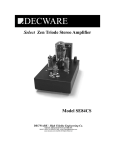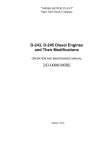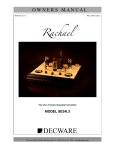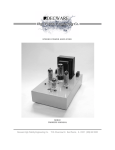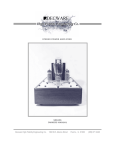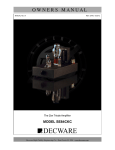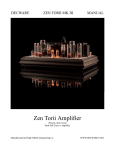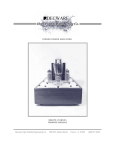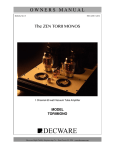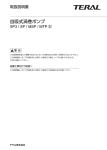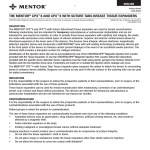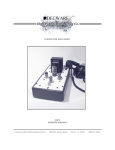Download Decware SE84CS Specifications
Transcript
OWNERS MANUAL MANUAL NO. 01 REV. DATE: 2/2008 Zen Triode Amplifier Model SE84C+ 2 watt stereo or 6 watt mono SET amplifier MORE INFORMATION ON THIS PRODUCT CAN BE FOUND ON www.decware.com DECWARE tm High Fidelity Engineering Co. OWNERS MANUAL MANUAL NO. 01 REV. DATE: 2/2008 5U4/5AR4 POWER TRANSFORMER EL84/SV83 SPEAKER JACKS EL84/SV83 6N1P/6922/6DJ8 VOLUME BIAS SWITCH INPUT SELECTOR FIGURE 1 Zen Triode Amplifier Model SE84C+ 2 watt stereo or 6 watt mono SET amplifier MORE INFORMATION ON THIS PRODUCT CAN BE FOUND ON www.decware.com DECWARE tm High Fidelity Engineering Co. OWNERS MANUAL MANUAL NO. 01 REV. DATE: 2/2008 CHANNEL A RIGHT INPUT CHANNEL B RIGHT INPUT POWER SWITCH CHANNEL A LEFT INPUT CHANNEL B RIGHT INPUT IEC CONNECTOR WITH HIDDEN 3 AMP FUSE FIGURE 2 Zen Triode Amplifier Model SE84C+ 2 watt stereo or 6 watt mono SET amplifier MORE INFORMATION ON THIS PRODUCT CAN BE FOUND ON www.decware.com DECWARE tm High Fidelity Engineering Co. OWNERS MANUAL MANUAL NO. 01 REV. DATE: 2/2008 START UP After unpacking your Zen amp refer to figure 1 to install the supplied tubes. ABOUT THE TUBES Your amp is configured as a single ended triode with a single output tube per channel. The output tubes can be your favorite EL84/6BQ5 or SV83/6P15P. The amplifier has been designed with a common cathode bias circuit so that the two output tubes remain matched during operation even if you use unmatched output tubes. This concept is also known as “self balancing” and ensures perfect image focus even as the tubes age. The small tube in the front of the amplifier is called the input tube, and it’s purpose is to raise the input signal to a level sufficient to properly drive the output tubes. This small dual triode tube is handling both channels. You can use either a 6N1P or 6922/6DJ8 in this location. This is the tube that will make the largest change in how the amplifier sounds. Since the signature of every tube is slightly different, even tubes of the same number, using a dual triode is an advantage because it keeps the signatures identical on each channel. The last and largest tube is called the rectifier tube and can be your choice of 5U4 or 5AR4. There are also other compatible substitutions that will also work, but these two choices are what we recommend. TUBE LIFE The output tubes are the only ones that really wear out. They are rated for between 3000~5000 hours depending on which ones you use. As output tubes wear, they become less powerful and softer sounding. If your output tubes are more than a couple years old the best way to tell if they require replacement is to install a new set and listen for any differences. If the new set clearly sounds better, then you know the old ones are ready for retirement. Rectifiers and input tubes can last for what seems like forever, but they should be checked every few years using the same procedure. MORE INFORMATION ON THIS PRODUCT CAN BE FOUND ON www.decware.com DECWARE tm High Fidelity Engineering Co. OWNERS MANUAL MANUAL NO. 01 REV. DATE: 2/2008 START UP CONTINUED Now that you have the tubes installed and know what each one is for, hook your speakers and source up to the amplifier and turn it on. Be sure to have the volume control all the way down. After the tubes slowly light up and begin to work (about 20 seconds) you can slowly start to raise the volume. If you hear distortion it means the amp is still warming up. 60 seconds is the official warm up period before music will play without distortion. POWER OUTPUT Your amplifier will drive almost a dead short meaning a 2 ohm speaker wouldn’t bother it a bit. Because of this unique ability for a single ended amplifier it is able to drive every speaker with a good frequency balance. The issue is never going to be the amplifiers ability to drive a given speaker but rather how loud it will get and if that volume is satisfactory. Complex, low efficiency speakers typically have busy crossover networks which convert some of the initial 1st watt of power into heat before it ever reaches the drivers. With only a couple watts, you don’t want to waste any power into heat if you don’t have to. Ideal speakers are generally simpler designs with higher efficiencies. INPUT SENSITIVITY This is the amount of signal required to get full output from the amplifier or put another way, how much signal it takes to get the amp to clip. For whatever reason the industry over the years has typically used 1 volt as the requirement to bring an amplifier to full power and this is fine. However, the standard output of almost all CD players is 2 volts. We designed the Zen amps to use the full 2 volts to come to full power meaning that with a CD player hooked directly to the amplifier you would be able to turn the amplifier volume all the way up and reach the power limit just at the onset of clipping. This makes it very difficult to clip or distort the amplifier and consequently the amplifier has the worlds most graceful clipping—so much so that many people don’t even know when or if the amp is distorting. MORE INFORMATION ON THIS PRODUCT CAN BE FOUND ON www.decware.com DECWARE tm High Fidelity Engineering Co. OWNERS MANUAL MANUAL NO. 01 REV. DATE: 2/2008 START UP CONTINUED CLIPPING The first thing everyone is going to do when setting up a Zen amp with a given set of speakers is find out what the max volume is going to be and if that volume is enough. Because the clipping characteristics of this amplifier are so polite it can be hard to hear exactly when the amp is beginning to run out of power (clip) so here is a secret way to tell: Turn off the lights and look into the output tubes. There are some small square holes in the gray plate inside the tube where if you look through them you can see a blue glow on the internal grid of the tube. This blue plasma is your visual clipping indicator. Simply find the line of sight that lets you see the blue glow, and raise the volume of the amp until you see the glow start to flicker to the music. This is the max clean volume of the amplifier without distortion. You’ll likely find this to be at somewhere past 3/4 on the volume control and on some softer CD’s all the way up. BIAS SWITCH This switch as seen in figure 1 is here for one reason only—to change the sound of the amplifier giving you two possible sounds at any given point while listening. The switch changes the bias current of the input tube which results in a more laid back signature vs. a more pronounced signature. There is no right or wrong way to set this switch. Noone agrees on which way sounds best either, so it is a function of the source and or preamp you use as well as the type of speakers you have that determines which way will sound best to you. This switch can be operated while listening without damage to the amplifier or speakers even though you will hear a significant Tick, or Pop when the switch is changed. At 2 watts the amplifier is incapable of blowing up a speaker (even tweeters) On a similar note, the amplifier itself is impossible to blow up again for the same reason—it doesn’t have enough power to hurt itself. MORE INFORMATION ON THIS PRODUCT CAN BE FOUND ON www.decware.com DECWARE tm High Fidelity Engineering Co. OWNERS MANUAL MANUAL NO. 01 REV. DATE: 2/2008 START UP CONTINUED OUTPUT TRANSFORMERS and IMPEDANCE The Zen amp uses proprietary transformers. It’s output transformers are wound on grain oriented silicon steel & nickel cores. They are the results of years of R&D and are one of the substantial secrets behind the success of this amplifier. A couple things are different when compared to most other tube amps. First, the outputs (secondary windings that connect to the speakers) are floating with no reference to ground. Most amplifiers require that the negative speaker output be tied to ground. The Zen amp will work in either configuration meaning that if you did connect the negative speaker jack of each channel together, or each to ground, the amplifier will still work fine. The advantage of floating the outputs as we have is tied directly to 3D imaging and sound stage palpability. The acceptable speakers should fall between 2 and 8 ohms. There is no need to worry about changing the amp when changing speakers loads, for the amp it’s automatic. In several cases where higher efficiency drivers are used (100dB 1w/1m) it is possible to get good results with 16 ohm speakers as well. Just remember that the amp will increase in power as the speaker load (ohms) decrease. That means between a 4 ohm speaker and an 8 ohm speaker of the same rated efficiency, the 4 ohm speaker will play louder on a Zen amp. Unlike a solid state amplifier, it is OK to short the speaker wires together accidentally or on purpose. If for some reason the amplifier was on with the volume all the way up and the CD player on with no speakers attached, having the speaker outputs shorted together will actually protect the amp from possible damage to the output transformers. With most tube amps, this scenario would immediately damage the output transformers making shorting of the outputs mandatory when a speaker is not connected. But once again, the Zen amp is overbuilt and 2 watts is not enough to damage it’s transformers under any condition. I don’t know about you, but in my years as an audio nut, I’ve blown up a thing or two by accident… It’s nice to know that it is impossible to blow up your speakers and impossible to blow up the amplifier so it will never happen again. MORE INFORMATION ON THIS PRODUCT CAN BE FOUND ON www.decware.com DECWARE tm High Fidelity Engineering Co. OWNERS MANUAL MANUAL NO. 01 REV. DATE: 2/2008 START UP CONTINUED BREAK IN During the first few hours or days with your amplifier you will no doubt wonder about break-in, if for no other reason than hearing about it constantly every time you read about amplifiers. If you’re new to tube gear the amp will sound so good right out of the box that you will have a hard time worrying about break-in, so don’t. If you’ve been around the block once or twice, then the fastest way to break in the amp to a point where the sound stage and focus doesn’t change back and forth from good to bad is this: 5 hours on and playing music at a normal level followed by 5 hours off. Repeat this 5 times. This process will speed the seating of the dielectric in the coupling caps and you can then expect the amp to bloom in the very near future. Beyond this, the amplifier will continue to improve and become more refined over the next 200 hours or so. After that the output transformers season with age, like fine wine, so as the years go by your amplifier continues to sound sweeter and sweeter. WEAK LINKS Please, if even only for an evening, lift some of the handicaps you’ve placed on your new amplifier so you can hear more of it’s inner magic. The fidelity of your amplifier is limited by the weakest link in your system. The quality of your source component and interconnect cables is of paramount importance because you now have an amplifier so good it will never become the weak link. You can’t spend enough money on a source to hear how good the amplifier actually is, so each time you upgrade your source the amp will blow your mind. MORE INFORMATION ON THIS PRODUCT CAN BE FOUND ON www.decware.com DECWARE tm High Fidelity Engineering Co. OWNERS MANUAL MANUAL NO. 01 REV. DATE: 2/2008 START UP CONTINUED WEAK LINKS CONTINUED Make sure you pull your speakers well out into the room set up in a triangle with the listening chair. In this arrangement you will be able to hear the music go holographic with outrageous depth and width and amuse yourself with how well your speakers disappear. Statistically most owners of Zen amps have never heard the real potential and inner magic the amp is capable of. Because it sounds better than what they had, they stop exploring. Room acoustics are what create the boundary between potentials with this amplifier. Even with a 17,000.00 DAC as your source, you will not get to the magic place I’m talking about in an untreated room unless by shear luck. It is possible to take a spare bedroom of smallish size and create a dedicated listening space that literally sounds like it’s 40 x 100 feet with the performers perfectly rendered in 3D space throughout that dimension as if your walls didn’t exist. If people realized this was actually possible I think more would try it and report the rewards exceeded the effort by 10 fold. In this environment it is possible to hear deep into the music through the amplifier and differences between one high dollar amp and another become blatantly apparent while in an untreated room would be missed entirely. MAINTENANCE Cleaning should be done with the amplifier at room temperature and of course OFF. Tubes should be removed prior to cleaning. A damp towel with alcohol is ideal for removing smudge marks from the black powder coat finish. The input jacks can also be cleaned with alcohol on a Q-Tip swab inserted into the jack and rotated. If the Q-Tip comes out with any dark color on it, your jacks were dirty. Jacks can get dirty after only a single insertion of a noncleaned interconnect cable. Having clean connections is important. Finger oils do not help the sound. MORE INFORMATION ON THIS PRODUCT CAN BE FOUND ON www.decware.com DECWARE tm High Fidelity Engineering Co. OWNERS MANUAL MANUAL NO. 01 REV. DATE: 2/2008 MAINTENANCE CONTINUED Products like Caig DeOxit, ProGOld and other contact cleaners/enhancers can also be used as part of a regular maintenance program. Basically whenever you unhook your amplifier, you should clean the jacks. If you never unhook your amplifier, you should unhook it at least every 6 months and clean all the jacks. The amplifier is self biasing so there is no maintenance or adjustments to make after you install new tubes. POWER CORDS and CONDITIONING Upgraded power cords can and do make a difference when the overall strength of the audio chain begins to show a stock power cord as a weak link. It should be stated that we’ve heard as many high dollar power cords do little to improve things as we care to admit. However some are very noticeable. None will justify spending a grand or more unless you’ve gone off the deep end and wiring your entire breaker box with silver/Teflon and etc. It makes little sense to invest too much in a power cord if your going to plug it directly into the wall outlet because far more of a problem than the cord itself is the dirty power coming from the outlet. What does make sense is to purchase a simple isolation transformer rated for 500 Watts or so and use that to decouple yourself from the grid and all the nasty harmonics that float in it. Then take a good power cord plugged into the isolation transformer and you will have a result. TWEAKS The biggest thing regarding tweaking the amplifier itself is going to be tubes. Every tube, even those sharing the same numbers, will sound slightly different. Rolling tubes, in particular the input tube, with other brands and or NOS (New Old Stock) can yield some very synergistic effects. Beyond that the only really thing left would be vibration control. As you can see the amp is built like an army tank of thick steel so it’s not prone to resonate like a thin chassis will. Things like tube dampers and high mass stands or spikes in various combinations can further improve focus. MORE INFORMATION ON THIS PRODUCT CAN BE FOUND ON www.decware.com DECWARE tm High Fidelity Engineering Co. OWNERS MANUAL MANUAL NO. 01 REV. DATE: 2/2008 SERVICE AND REPAIR Your amp is covered parts and labor for the lifetime of the original owner. Should it ever need repair or you just want it checked contact us or fill out the RA form on our web site and send it to us. We’ll call you after it has arrived and let you know what we’ve found and determine the precise cause to prevent it from happening again. Less the 0.5% of Zen amps sold have required service since the amp was launched in 1996. GETTING THE MOST FROM YOUR ZEN Your amplifier comes with a lifetime warranty. Probably the only amplifier in production that has one. Decware is a small enough company to consider these hand built amplifiers more like children so we like to keep tabs on them, make sure they are in use and being enjoyed so they grow up to be great salesman. In that light, no one is going to buy a Zen amp if they come to your house and see it in the closet. If you’re not getting the sound you’re after or grow bored with it we already know the 26 reasons that created that condition and would be pleased to offer our sincere problem solving and consulting skills to help you find what your looking for. In some cases it means helping your sell your amp and getting something else. In other cases it’s speakers or tips on how to better set up your room without upsetting your spouse. Bottom line is we want you to enjoy music and stop listening to gear. The low power single ended approach has the potential to far exceed high power counterparts regardless of cost because of simple physics. Lower mass, higher efficiency / better speed, better linearity. You might think you need 500 watts to experience amazing dynamics but in reality, there is over 30 dB of dynamic range in the first watt. When you double that to 2 watts you gain 3 more dB. To gain another 3dB the power is doubled again and for every 3dB after that it doubles. So this is a game of preserving the first watt and being able to hear it. In a high power system, much of the first watt is spent into heat from complicated crossover networks and along with it much of that initial 30dB of dynamic range. MORE INFORMATION ON THIS PRODUCT CAN BE FOUND ON www.decware.com DECWARE tm High Fidelity Engineering Co. OWNERS MANUAL MANUAL NO. 01 REV. DATE: 2/2008 We have developed affordable speakers based on this ideal that range in efficiency from 94 to 99 dB with 1 watt and have no crossovers. These type of speakers will demonstrate real dynamics and can give a real education in microdynamics often buried in higher power systems. SPECIFICATIONS: Weight Dimensions Circuit type Power output Input voltage Noise / Hum Response Feedback Rectification Output tubes Signal tube Transformers Biasing Resistors Signal Cap AC cord Consumption Input jacks Output jacks Speaker dB/1w Warranty 17 lbs. ea. 8.0" H x 6.125" W x 12.0" D Single ended Class A Triode 2.3 watts RMS into 4 ohms 5 watts RMS into 8 ohms bridged Power increases as ohms decrease Stable into 1 ohm speaker loads 2.0 volts for full output Less than 1.5 millivolts 20 Hz ~ 20 kHz ZERO negative feedback used 5U4G / tube rectification SV83 or EL84/6BQ5 6N1P or 6922 or 6Dj8 9800 ohm Decware Self-Biasing precision WW/MF by DALE, VISHAY Polyurethane Film Removable power cord 65 watts at full power RCA type 24K Gold / Teflon 5-way binding posts accept 12 gauge 89 dB minimum / 96 dB is ideal Lifetime to original owner MORE INFORMATION ON THIS PRODUCT CAN BE FOUND ON www.decware.com DECWARE tm High Fidelity Engineering Co.













